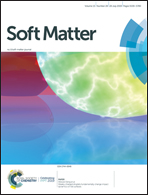Exploration of the reactive modelling of sol–gel polycondensation in the presence of templates†
Abstract
The polycondensation of silicic acid, methylsilicic acid, or their mixture was studied by reactive force field simulation. These were found to be feasible systems for the simulation of two-step acid hydrolysis–alkaline condensation of their alkoxysilane counterparts, usually taken experimentally as sol–gel precursors. The approach avoided the alkoxysilane hydrolysis step and allowed high degrees of polycondensation at relatively low temperature (700–1000 K), from the computational efficiency perspective. Being the ultimate interest of the present study the sol–gel polycondensation of templated gels whose microstructural pattern is affected by the presence of a template, the role of the intermolecular forces was decisive, and promoted high polycondensation at the lowest possible temperature. Polycondensation with added damascenone did not result in any perceived templating effect, i.e., damascenone was not able to interact significantly with the growing clusters, in a way that would allow its occlusion or a surface molding effect on the clusters. A possible reason for this is the intermolecular interaction strength being too weak at the temperatures set for the simulations. However, when using luteolin as the template, a molecule with several hydrogen bond interaction points, it was possible to observe different microscopic events involving the template molecules, some of them corresponding to actual templating effects, such as partial enveloping by the network around the template. These restricted events did not allow the inference of any macroscopic property of the final gel. However, it was shown that polycondensates shaped by the template or a template dimer may be obtained. The sites thus obtained will be essential for future in silico studies of the selectivity of such sites.



 Please wait while we load your content...
Please wait while we load your content...